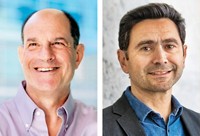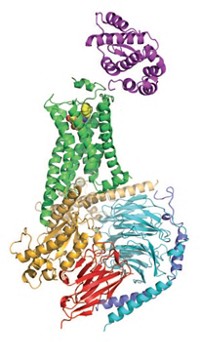Advertisement
Grab your lab coat. Let's get started
Welcome!
Welcome!
Create an account below to get 6 C&EN articles per month, receive newsletters and more - all free.
It seems this is your first time logging in online. Please enter the following information to continue.
As an ACS member you automatically get access to this site. All we need is few more details to create your reading experience.
Not you? Sign in with a different account.
Not you? Sign in with a different account.
ERROR 1
ERROR 1
ERROR 2
ERROR 2
ERROR 2
ERROR 2
ERROR 2
Password and Confirm password must match.
If you have an ACS member number, please enter it here so we can link this account to your membership. (optional)
ERROR 2
ACS values your privacy. By submitting your information, you are gaining access to C&EN and subscribing to our weekly newsletter. We use the information you provide to make your reading experience better, and we will never sell your data to third party members.
Nobel Prize
Robert Lefkowitz And Brian Kobilka Share 2012 Nobel Prize In Chemistry
Awards: Scientists take prize for unveiling the function of G-protein-coupled receptors
by Carmen Drahl
October 10, 2012

Robert J. Lefkowitz, 69, and Brian K. Kobilka, 57, will take home this year’s Nobel Prize in Chemistry for unraveling the molecular workings of G-protein-coupled receptors (GPCRs). The receptors are a family of proteins that transmit critical biological messages for functions such as vision, smell, taste, and neurotransmission.

Lefkowitz and Kobilka’s discoveries also laid the foundation for a flurry of structures of GPCRs solved over the past five years, the Nobel committee said at an Oct. 10 press conference. Those structures explain at atomic-level detail how the receptors, which always wind back and forth seven times through cell membranes, transmit messages.
GPCRs “are crucially positioned to regulate almost every known physiological process in humans,” Lefkowitz, a Howard Hughes Medical Institute investigator based at Duke University Medical Center, said by phone at the press conference. For decades, researchers knew that hormones such as adrenaline outside cells led to changes inside cells. But the exact nature of this chemical signaling was a mystery. Lefkowitz first traced this signaling with radioactive blocking agents. Eventually, his team managed to pluck GPCRs—including the receptor for adrenaline, the β-adrenergic receptor—out of the tissues where they had always been studied.
Kobilka, now at Stanford University School of Medicine, was a postdoc in Lefkowitz’ lab in the 1980s, when the lab was hunting for the gene encoding the β-adrenergic receptor. When Kobilka finally isolated the gene, he realized the receptor comprised seven helices, just like rhodopsin, which resides in the retina and responds to light. The Lefkowitz team realized that a large family of seven-helix receptors must exist. “Lefkowitz and Kobilka have helped us understand the molecular details of cellular signaling,” says American Chemical Society President Bassam Z. Shakhashiri. “It is helping chemists create new medicines that will benefit society.”
GPCRs are targets for as many as 50% of prescription medicines on the market, but many of those drugs, such as beta-blockers, date to long before the prizewinning discoveries. “Chemists made early GPCR drugs by just making molecules related to natural hormones or neurotransmitters,” says Fiona H. Marshall, chief scientific officer of Heptares Therapeutics, a firm that specializes in GPCR drug discovery. Lefkowitz and Kobilka’s work allows medicinal chemists to understand better the proteins they are targeting as they go about designing new drugs, she adds. Although the Nobel committee pointed to Kobilka’s more recent research achievements, including the first X-ray crystal structure of a GPCR bound to its signaling partner, “this Nobel Prize is not just about the GPCR structure,” Marshall says. “That was the icing on the cake at the end.”
Lefkowitz and Kobilka will split the $1.2 million prize, which Lefkowitz said he didn’t anticipate. “I can assure you I did not go to sleep last night waiting for this call.” His original plan for the day, he said, included getting a haircut.






Join the conversation
Contact the reporter
Submit a Letter to the Editor for publication
Engage with us on Twitter